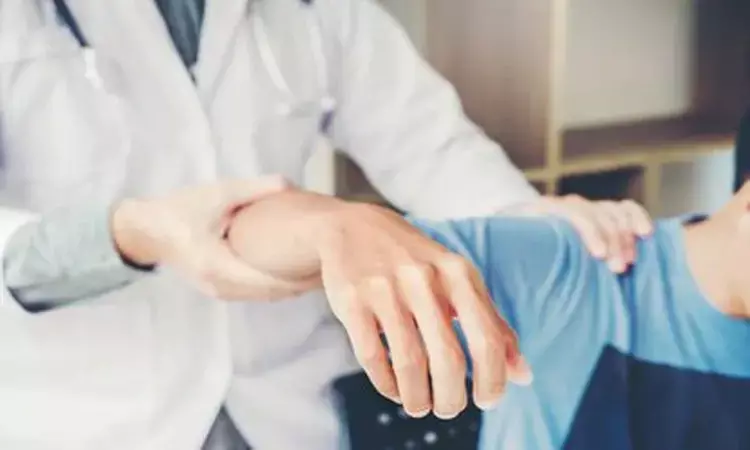- Home
- Medical news & Guidelines
- Anesthesiology
- Cardiology and CTVS
- Critical Care
- Dentistry
- Dermatology
- Diabetes and Endocrinology
- ENT
- Gastroenterology
- Medicine
- Nephrology
- Neurology
- Obstretics-Gynaecology
- Oncology
- Ophthalmology
- Orthopaedics
- Pediatrics-Neonatology
- Psychiatry
- Pulmonology
- Radiology
- Surgery
- Urology
- Laboratory Medicine
- Diet
- Nursing
- Paramedical
- Physiotherapy
- Health news
- Fact Check
- Bone Health Fact Check
- Brain Health Fact Check
- Cancer Related Fact Check
- Child Care Fact Check
- Dental and oral health fact check
- Diabetes and metabolic health fact check
- Diet and Nutrition Fact Check
- Eye and ENT Care Fact Check
- Fitness fact check
- Gut health fact check
- Heart health fact check
- Kidney health fact check
- Medical education fact check
- Men's health fact check
- Respiratory fact check
- Skin and hair care fact check
- Vaccine and Immunization fact check
- Women's health fact check
- AYUSH
- State News
- Andaman and Nicobar Islands
- Andhra Pradesh
- Arunachal Pradesh
- Assam
- Bihar
- Chandigarh
- Chattisgarh
- Dadra and Nagar Haveli
- Daman and Diu
- Delhi
- Goa
- Gujarat
- Haryana
- Himachal Pradesh
- Jammu & Kashmir
- Jharkhand
- Karnataka
- Kerala
- Ladakh
- Lakshadweep
- Madhya Pradesh
- Maharashtra
- Manipur
- Meghalaya
- Mizoram
- Nagaland
- Odisha
- Puducherry
- Punjab
- Rajasthan
- Sikkim
- Tamil Nadu
- Telangana
- Tripura
- Uttar Pradesh
- Uttrakhand
- West Bengal
- Medical Education
- Industry
Strength training of non-hemiplegic side may improve motor recovery in diseased limb

Strength training of the non-hemiplegic side (NHS) improved the motor function like balance, mobility, and muscle strength of patients with stroke. The findings of this study was published in the Archives of Physical Medicine and Rehabilitation.
The study by Chenlan Shao recruited 139 patients with first stroke and randomly separated them into a trial group (n=69) or control group (n=70). The control group underwent usual rehabilitation training, including step training and trunk control training in standing position. The trial group underwent strength training of NHS on the basis of usual rehabilitation training. The strength training of NHS included lower limb stepping training with resisting elastic belt and upper limb pulling elastic belt training in standing position. The training for both groups was 45 min, once a day, 5 days a week for 6 weeks.
The primary outcome measures were balance evaluation done with the Berg Balance Scale (BBS); mobility assessment with the 6-minute walk test (6-MWT); activities of daily life was examined via the modified Barthel Index (MBI); muscle strengths of the biceps brachii, iliopsoas, and quadriceps were measured via the isokinetic muscle strength testing system. All assessments were performed at baseline (T0) and after the intervention (T1).
Also, the trial group performed better than control group in BBS scores (adjusted mean difference: 6.83; 95% confidence interval [CI]: 4.71-8.94) and 6-MWT (adjusted mean difference: 50.32; 95% CI: 40.58-60.05) after intervention.
In terms of muscle strength of the hemiplegic side, the trial group displayed greater gains in biceps brachii, iliopsoas, and quadriceps than control group after intervention.
In conclusion, the study found that strength training of the NHS can promote recovery of balance, mobility, and muscle strength of the paretic side of patients with stroke. The study suggests that NHS strength training may be a valuable addition to usual rehabilitation training for patients with stroke.
Source:
Shao, C., Wang, Y., Gou, H., Xiao, H., & Chen, T. (2022). Strength Training of the Nonhemiplegic Side Promotes Motor Function Recovery in Patients With Stroke: A Randomized Controlled Trial. In Archives of Physical Medicine and Rehabilitation. Elsevier BV. https://doi.org/10.1016/j.apmr.2022.09.012
Neuroscience Masters graduate
Jacinthlyn Sylvia, a Neuroscience Master's graduate from Chennai has worked extensively in deciphering the neurobiology of cognition and motor control in aging. She also has spread-out exposure to Neurosurgery from her Bachelor’s. She is currently involved in active Neuro-Oncology research. She is an upcoming neuroscientist with a fiery passion for writing. Her news cover at Medical Dialogues feature recent discoveries and updates from the healthcare and biomedical research fields. She can be reached at editorial@medicaldialogues.in
Dr Kamal Kant Kohli-MBBS, DTCD- a chest specialist with more than 30 years of practice and a flair for writing clinical articles, Dr Kamal Kant Kohli joined Medical Dialogues as a Chief Editor of Medical News. Besides writing articles, as an editor, he proofreads and verifies all the medical content published on Medical Dialogues including those coming from journals, studies,medical conferences,guidelines etc. Email: drkohli@medicaldialogues.in. Contact no. 011-43720751


